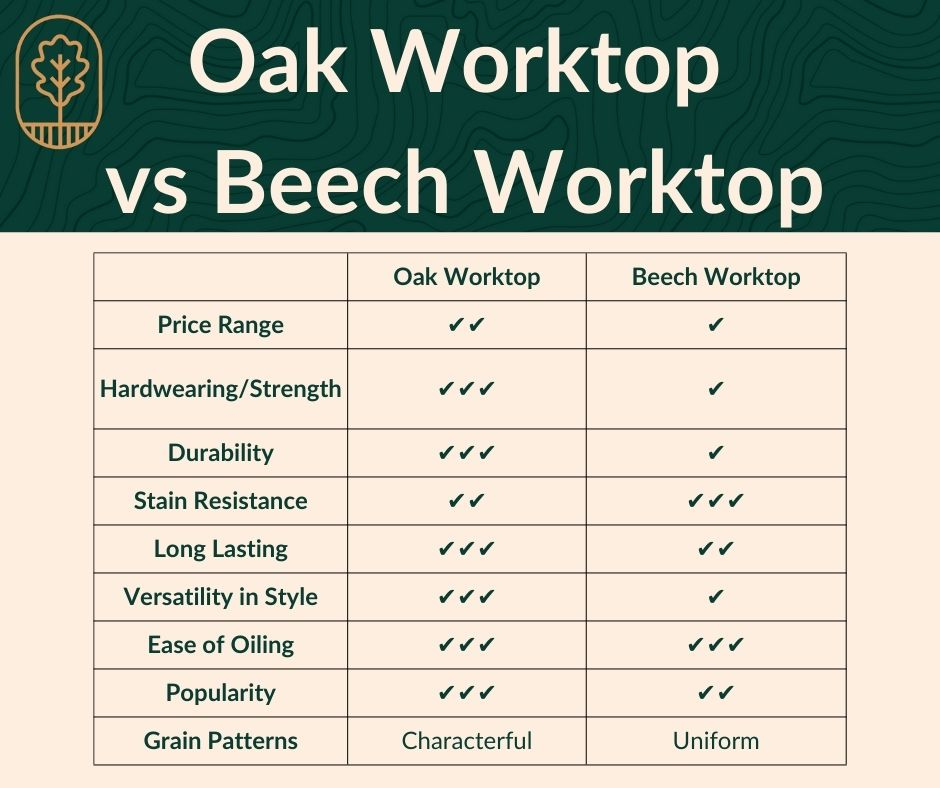There is an ever-ongoing debate as to which wooden worktops are better. And it’s definitely not the easiest question to answer.
Despite the fact that the British people have a deep cultural connection and strong links with the oak tree, beech is not that far behind. In fact, it’s the second most popular wood worktop type in the UK.
Whether modern or traditional, both wood types offer the versatility to fit well with any kitchen style and design. Oak worktops are usually light yellowish in colour and have a bold character, while beech worktops are often pinkish in colour and offer a more uniform grain pattern.
In the end, personal preference and the final style of the kitchen may well be the deciding factor when picking the worktop, but let’s take a look at some of the other pros and cons of each wood type.

Affordability
Solid beech worktop is the most affordable hardwood worktop material and is a very popular choice for kitchen designers or renovators working on a tight budget. The high abundance of beech trees across European hardwood forests is perhaps one of the reasons for its affordable nature.

On the other hand, an oak worktop may come at a more premium price point thanks to its extremely attractive aesthetic appeal and the variety of finishes available. Full stave oak worktops – where the wood runs full length without additional joins – are highly popular among mid to higher-end kitchens seeking that minimalist, deluxe finish.
While standard oak worktops (a slightly less pricy alternative to a beech worktop), are again more popular among kitchen designs on a smaller budget.
Stain resistance
In their natural state, a beech worktop can offer more stain resistance than oak. However, both oak and beech worktops should be properly sealed with oil for best long-term performance. If sealed both of the worktops are offering very good stain resistance.
If untreated, oak in particular contains a high amount of tannin, which, when it comes into contact with acid can leave black marks on the surface of the worktop.
As they say, prevention is better than cure – always oil your worktop to keep it protected!

Wearability & durability
Although both are very durable hardwood types, oak is more hardwearing than beech when it comes to wood worktops.
Oak has a density of 800 kg per cubic meter, while beech has a density of 700 kg per cubic meter. Hence, oak is associated with strength and it’s not a coincidence that “strong as an oak” is an enduring phrase in the British lexicon. Moreover, oak is well-known for its ageing look as its grain colour gradually gets deeper, becoming more and more vibrant. Just like red wine, its look tends to get better and better with time.
So, while oak might take a slight lead in general durability properties, if well looked after, both of these wood worktop types will last for many years.
Ease of maintenance

Maintenance of hardwood products is considered their main – and perhaps only – negative aspect, as they may require regular oiling. However, in reality, it is very quick and easy to oil wooden worktops and oiling does not require any particular skills.
You can find in-depth information and a step-by-step guide on how to oil your worktop here. At House of Worktops, we use Osmo oil for the perfect finish.
However, if you’d like more information generally about which oil to use or how to apply it, do get in touch with our sales team on 01727 260688 or sales@houseofworktops.co.uk.
Conclusion
In this article, we’ve taken a look at the main benefits and drawbacks of oak & beech wood worktops.
There’s no doubt both are excellent choices for almost any style of kitchen or home design. But which one should you buy?
If you’re on a very strict budget, then beech may well be the obvious choice.
And if you’ve got a little more freedom to spend?
We don’t like to pick sides. But at a push, based on our many years of experience, we’d have to say that oak is the number one worktop choice of the two.
And while it may be a little pricier, the natural benefits of oak’s properties – especially its longevity – more than justifies the premium.
If you’re still struggling to decide, why not order our next-day samples and take a look at the 2 woods in person – it might be just the inspiration you need!









